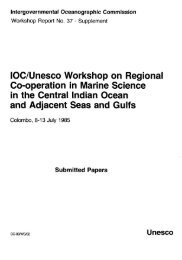Manual on sea level measurement and ... - unesdoc - Unesco
Manual on sea level measurement and ... - unesdoc - Unesco
Manual on sea level measurement and ... - unesdoc - Unesco
- No tags were found...
You also want an ePaper? Increase the reach of your titles
YUMPU automatically turns print PDFs into web optimized ePapers that Google loves.
Sea Level Measurement <strong>and</strong> Interpretati<strong>on</strong>APPENDIX I.GLOSS Requirements for Tide Gauges(update from the third editi<strong>on</strong> of the manual)The aim of any tide gauge recording should be to operatea gauge which is accurate to better than 1 cm atall times; i.e. in all c<strong>on</strong>diti<strong>on</strong>s of tide, waves, currents,weather etc. This requires dedicated attenti<strong>on</strong> to gaugemaintenance <strong>and</strong> data quality c<strong>on</strong>trol. In brief, the majorrequirements for GLOSS stati<strong>on</strong>s are (IOC, 1997):• A sampling of <strong>sea</strong> <strong>level</strong>, averaged over a period l<strong>on</strong>genough to avoid aliasing from waves, at intervals oftypically 6 or 15 minutes, or even 1 minute or less ifthe instrument is to be used also for tsunami warning(IOC 1997 states: ‘but in all circumstances theminimum sampling interval should be <strong>on</strong>e hour’,which these days is an insufficient sampling formost agencies);• Gauge timing be compatible with <strong>level</strong> accuracy,which means a timing accuracy better than <strong>on</strong>eminute (<strong>and</strong> in practice, to sec<strong>on</strong>ds or better, withelectr<strong>on</strong>ic gauges);• Measurements must be made relative to a fixed <strong>and</strong>permanent local tide gauge bench mark (TGBM).This should be c<strong>on</strong>nected to a number of auxiliarymarks to guard against its movement or destructi<strong>on</strong>.C<strong>on</strong>necti<strong>on</strong>s between the TGBM <strong>and</strong> thegauge zero should be made to an accuracy of a fewmillimetres at regular intervals (e.g. annually);• GLOSS gauges to be used for studies of l<strong>on</strong>g termtrends, ocean circulati<strong>on</strong> <strong>and</strong> altimeter calibrati<strong>on</strong>need to be equipped with GPS receivers (<strong>and</strong>m<strong>on</strong>itored possible by other geodetic techniques)located as close to the gauge as possible;• The readings of individual <strong>sea</strong> <strong>level</strong>s should bemade with a target accuracy of 10 mm;• Gauge sites should, if possible, be equipped forrecording tsunami signals, implying that the site beequipped with a pressure sensor capable of 15-sec<strong>on</strong>dsor 1-minute sampling frequency, <strong>and</strong> possiblyfor recording wave c<strong>on</strong>diti<strong>on</strong>s, implying 1-sec<strong>on</strong>dsampling frequency;• Gauge sites should be also equipped for automaticdata transmissi<strong>on</strong> to data centres by means of satellite,Internet etc., in additi<strong>on</strong> to recording datalocally <strong>on</strong> site;• Sea <strong>level</strong> <strong>measurement</strong>s should be accompanied byobservati<strong>on</strong>s of atmospheric pressure, <strong>and</strong> if possiblewinds <strong>and</strong> other envir<strong>on</strong>mental parameters,which are of direct relevance to the <strong>sea</strong> <strong>level</strong> dataanalysis.Regular (e.g. daily) inspecti<strong>on</strong> of data will informoperators when a gauge is malfuncti<strong>on</strong>ing, <strong>and</strong>lead to overall better l<strong>on</strong>g-term data sets. Datafrom gauges in polar or other remote locati<strong>on</strong>s willinevitably be inspected less frequently, unless satellitedata transmissi<strong>on</strong> can be installed. Similarly, datafrom the relatively few gauges recording <strong>on</strong>ly <strong>on</strong>paper charts will be slow to reach centres for qualityc<strong>on</strong>trol; these must be c<strong>on</strong>sidered priorities forupgrading to meet modern st<strong>and</strong>ards.Operators of gauges must always be aware of possiblesystematic jumps in <strong>sea</strong> <strong>level</strong> time-series when<strong>on</strong>e form of recording is replaced by a ‘better’<strong>on</strong>e. All gauges have systematic errors, but thoseerrors will be irrelevant for time-series work if thesame technique is used throughout. New-technologygauges are, by definiti<strong>on</strong>, less well understoodthan old <strong>on</strong>es, <strong>and</strong> they must always be operatedal<strong>on</strong>gside the older <strong>on</strong>es until sufficient experiencehas been acquired.52IOC <str<strong>on</strong>g>Manual</str<strong>on</strong>g>s <strong>and</strong> Guides No 14 vol IV
















